The Inexpensive Wall Design Rock The Block's Alison Victoria Absolutely Loves
In season four, episode four, "Lower Level Face-Off," of HGTV's "Rock the Block," another set of designers is split into four teams and challenged with a basement renovation on a budget and limited timeline. With interior designer and "Wendy City Rehab" host Alison Victoria as one of the judges, designers begin their renovations, assessing how to revamp the space affordably. Michel Smith Boyd from "Luxe for Less" settles on using tambour wood for wall paneling. "I am kind of in love with tambour," Smith Boyd said, per Realtor.com. "It's really a super contemporary and super popular way to design right now."
Victoria agrees with Smith Boyd's praise of tambour as wall paneling, saying, "You have done something that cost almost nothing, and you have made a million-dollar wall here." Tambour paneling is inexpensive compared to other options, costing between $100 to $500 for every 4 to 8 feet, depending on slab sizes, thickness, and customizations such as color and wood type. Due to its pliability, tambour makes the perfect material for all the curves and corners of our walls.
What is tambour wood?
Tambour wood is not so much a type of wood but a style. Tambour paneling can be made up of different kinds of solid wood like maple, red oak, walnut, and white oak. It's the linear slats on a flexible backing that really sets this design trend apart. Similar in fashion to beadboard, tambour is affordable, durable, and versatile. Its raised paneling adds dimension and texture to a room, which Victoria believes to be a crucial quality. "When I do accent walls in rooms, I don't do a paint color," she said (via New York Post). "I think it's so noncommittal... let's bring texture in, let's bring depth and color and contrast -– and I think there's no better way to do that than another material."
While tambour is a budget-friendly wall paneling option, it has many other uses in home décor. Particularly popular in the late 70s and 80s, tambour wood was frequently used on cabinetry, sliding doors, rolltop desk covers, and shelving. This grooved surface material can also make an impact when placed on ceilings, columns, and other furnishings like coffee tables and credenzas. When utilizing tambour in the home, one may want to be cautious of separating or warping slats and note that with its fissures will come dust and grime accumulation that may be harder to keep clean.

